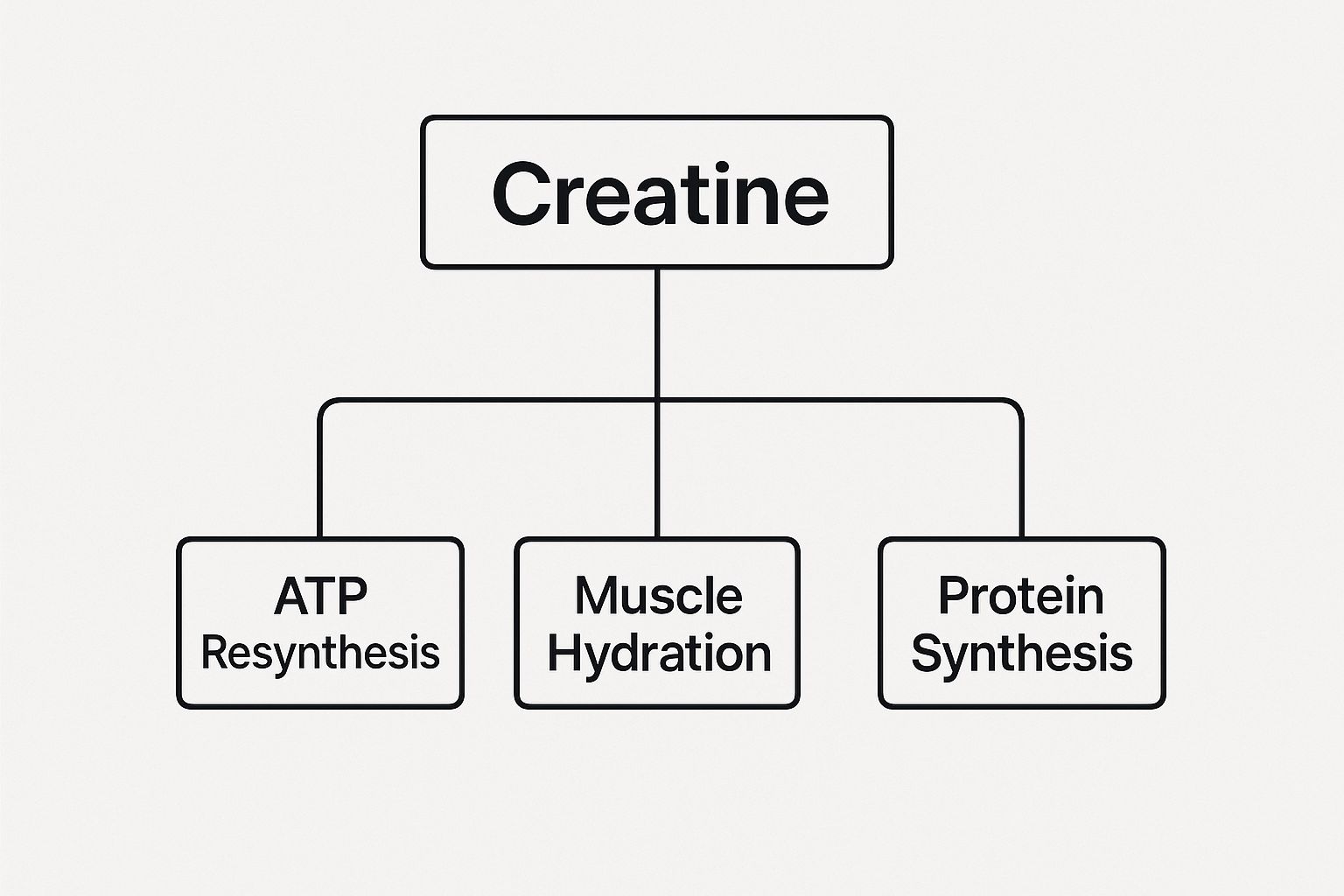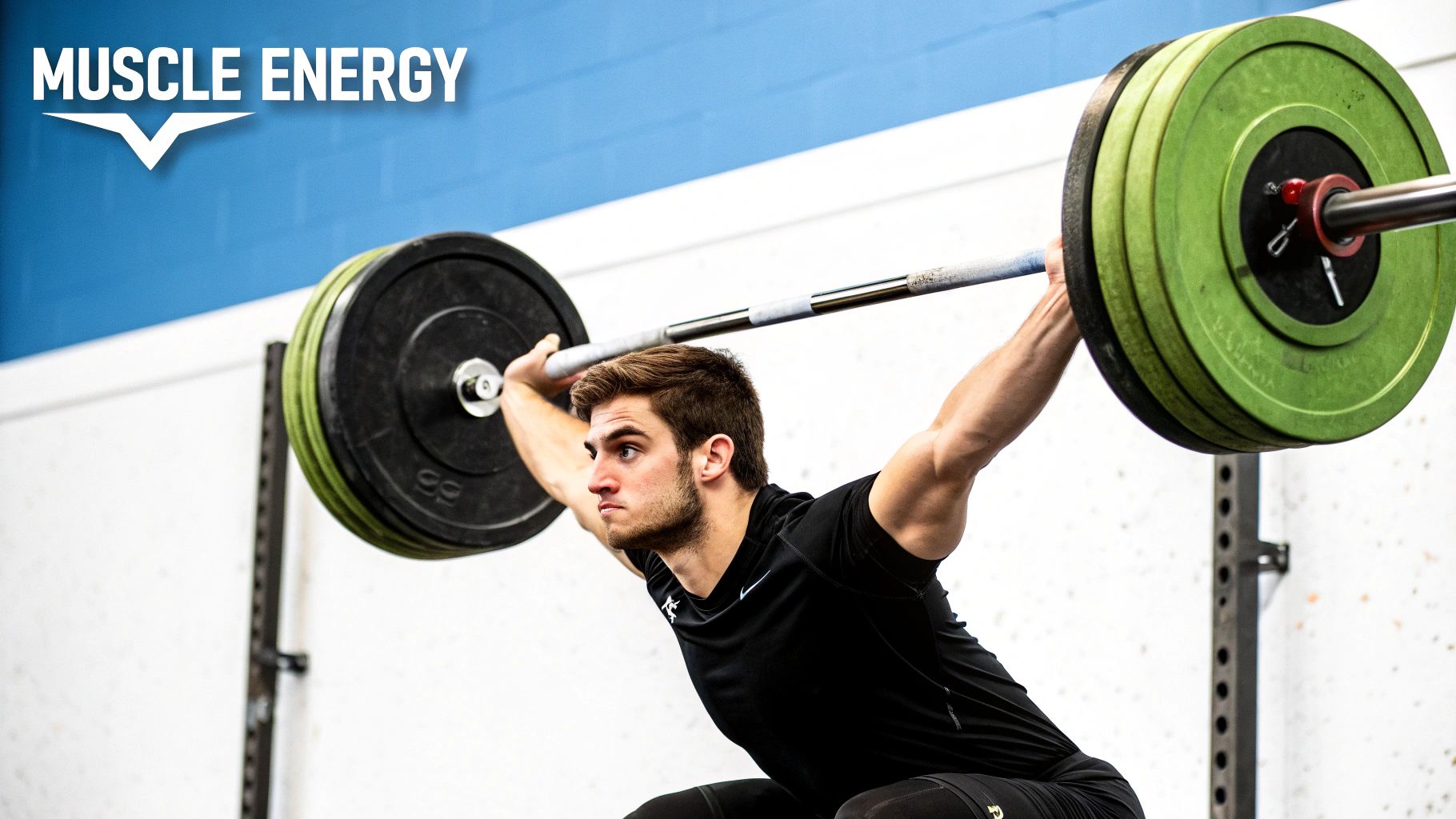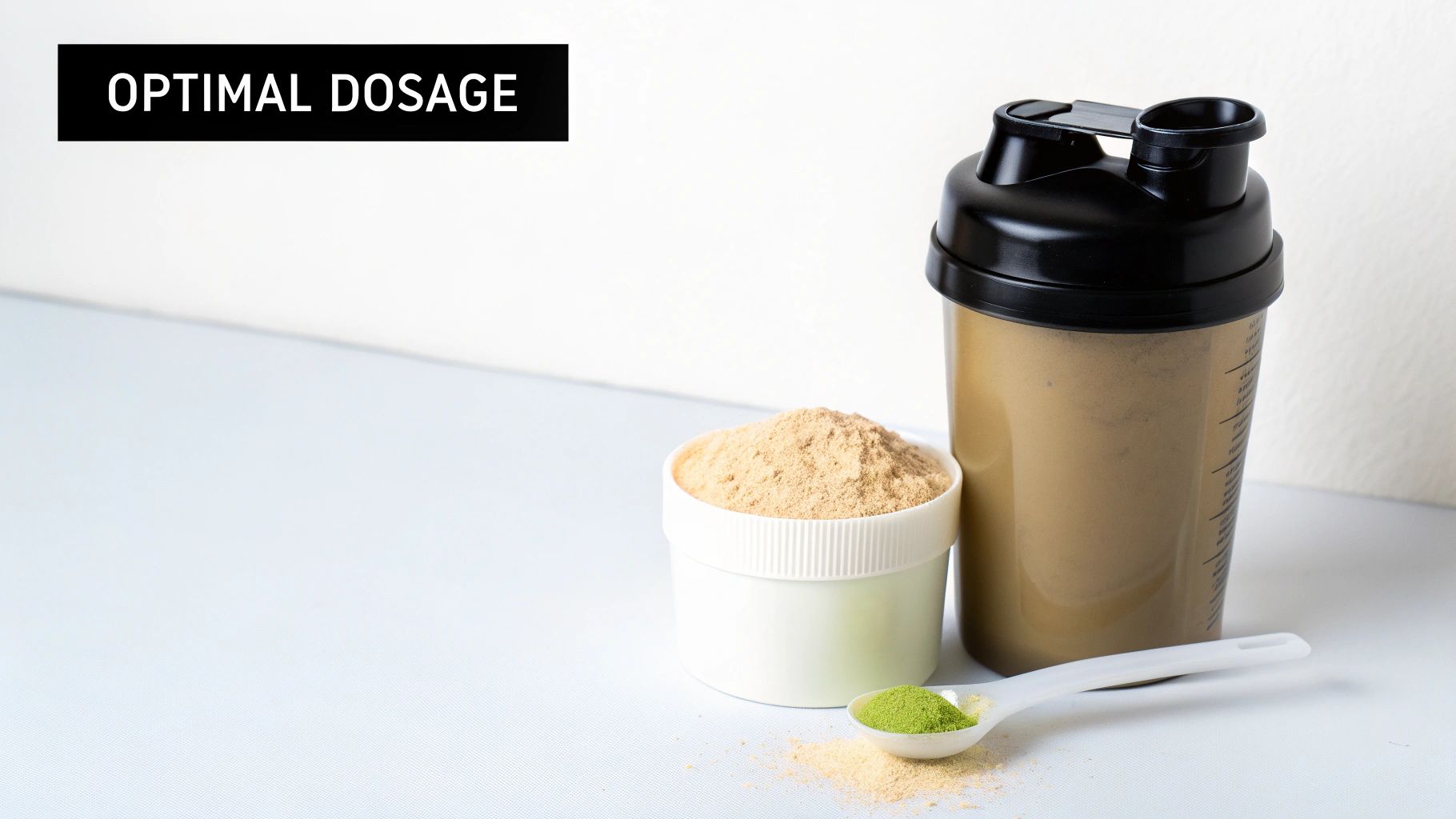
Creatine for Muscle Growth: The Ultimate Science-Based Guide
Share
Understanding How Creatine Powers Your Muscle Growth
To get how creatine helps build muscle, we need to peek inside the muscle cell. Think of your muscles as high-performance engines. During short, intense bursts of effort—like a heavy squat or a sprint—they burn a specific, high-octane fuel called Adenosine Triphosphate (ATP). The catch is, your muscles only store enough ATP for a few seconds of all-out work. Once it's depleted, your power and performance take a nosedive. This is where creatine steps in as your body's personal energy recycling plant.
When you take creatine, you boost your body's reserves of a compound called phosphocreatine. Picture phosphocreatine as a backup battery pack. As your muscles burn through ATP, phosphocreatine quickly donates a phosphate molecule to regenerate it. This rapid replenishment allows your muscles to sustain high-intensity effort for longer. Instead of hitting a wall at six reps, you might be able to push out eight or nine. Over weeks of consistent training, those extra reps add up to real gains in strength and size.
The Three Pillars of Creatine's Power
Creatine’s effect on muscle growth isn't just about one thing; it operates through a trio of powerful biological processes. Together, they create the perfect storm for building new muscle.
This infographic shows how creatine supports muscle growth through three primary pathways: ATP resynthesis, muscle hydration, and enhanced protein synthesis.

As you can see, these three pillars work in concert. This shows that creatine is more than a simple energy supplement; it’s a multifaceted tool for muscle development.
Let’s explore how each pillar contributes to your goals:
- Improved Workout Capacity (ATP Resynthesis): As we covered, this is the most direct benefit. More energy means you can lift heavier weights for more reps, which is the core signal for your muscles to grow (hypertrophy).
- Cell Volumization (Muscle Hydration): Creatine is an osmotic compound, which means it pulls water into your muscle cells. This process, known as cell volumization, does more than just give your muscles a fuller, "pumped" appearance. The increased water content acts as an anabolic (muscle-building) signal, which can help trigger muscle protein synthesis and reduce muscle breakdown.
- Signaling Muscle Growth (Protein Synthesis): Beyond its energy and hydration functions, creatine also seems to directly influence the biological pathways that build muscle. Research indicates it can increase the activity of satellite cells—your muscle's "stem cells"—and activate genes responsible for repairing and constructing new muscle fibers.
To better understand how these mechanisms work together, let's break them down in the table below. It details how each process driven by creatine contributes to your muscle-building journey.
| Growth Mechanism | How Creatine Helps | Impact on Muscle Building | Timeline |
|---|---|---|---|
| Increased ATP Resynthesis | Rapidly regenerates ATP, the primary fuel for short, intense muscle contractions. | Allows for more reps and heavier lifts during training, creating a greater stimulus for growth. | Immediate performance boost (within days of saturation). |
| Cell Volumization | Pulls water into muscle cells, increasing their size and hydration. | The "pump" acts as an anabolic signal, promoting protein synthesis and reducing protein breakdown. | Visible fullness within the first week of loading. |
| Enhanced Protein Synthesis | Upregulates anabolic signaling pathways and increases the activity of satellite cells. | Directly stimulates the repair and construction of new muscle fibers, leading to long-term hypertrophy. | Gradual, building over weeks and months of training. |
This table shows that creatine offers both immediate performance benefits and long-term structural changes. The quick energy boost lets you train harder right away, while the signaling and hydration effects create a sustained environment for muscle growth over time.
From Lab Discovery to Gym Staple
The confidence in creatine's effectiveness isn't a recent development. Its benefits were first proven in clinical settings in the early 1990s through groundbreaking muscle biopsy studies. A pivotal 1992 experiment demonstrated that taking creatine orally could increase the amount stored in muscles by about 20%. This confirmed that what you consume translates directly into more fuel for your workouts.
You can learn more about these early creatine findings on GSSIweb.org and see how this initial research paved the way for its widespread use. This work turned creatine from a scientific curiosity into a foundational supplement for athletes and fitness enthusiasts everywhere.
The Real Muscle-Building Results You Can Expect
Now that you know the "how" behind creatine's power, let's get into the "what." What kind of real-world results can you actually see from adding creatine to your supplement stack? It’s easy to get carried away by bold claims, but setting realistic expectations is crucial for your long-term fitness journey. While results will differ from person to person, they are consistently positive for most people who combine creatine with a solid training plan.

From Water Weight to Quality Muscle
One of the first things you'll probably notice is the number on the scale creeping up within the first week. This initial jump is mostly due to the cell volumization we talked about earlier—your muscles are pulling in more water. This isn't fat gain; it's a great sign that your muscles are getting saturated with creatine. This initial "water weight" can be anywhere from 2 to 5 pounds and often gives your muscles a fuller, more "pumped" appearance.
While that early boost is motivating, the real benefit of creatine for muscle growth unfolds over the weeks and months that follow. Because creatine helps you train harder and more consistently, you’ll start to build genuine, high-quality muscle tissue. This is where the results get truly impressive. A massive review of over 150 studies showed that creatine users increased their lean body mass by an average of 2.2% more than non-users. In another study focusing on well-trained athletes, those using creatine gained an average of 5.7 pounds (2.6 kg) of solid muscle. You can discover more about these creatine findings on Essex.ac.uk to see just how significant the impact can be.
How Your Experience Level Shapes Your Results
Your current training background plays a big part in the results you'll see. Beginners often experience the most dramatic changes because their bodies are highly receptive to new training stimuli. For them, creatine can be a powerful accelerator, helping them smash through early strength plateaus and build a solid muscle foundation much faster.
Experienced lifters, who are closer to their genetic ceiling, will see more gradual but still important gains. For a seasoned athlete, packing on an extra 2-3 pounds of lean muscle over several months is a huge win. Creatine helps them eke out those extra percentage points of progress that become so much harder to achieve over time.
To give you a clearer picture, the table below shows what you might realistically expect based on your training history when you pair resistance training with creatine.
Table: Expected Muscle Growth Results by Training Level
| Training Level | Average Muscle Gain (8 weeks) | Strength Improvement | Body Fat Change |
|---|---|---|---|
| Beginner | 4-7 lbs (1.8-3.2 kg) | Significant increases in major lifts | Potential decrease with consistent training |
| Intermediate | 3-5 lbs (1.4-2.3 kg) | Steady progress on existing lifts | Slight decrease or maintenance |
| Advanced | 1-3 lbs (0.5-1.4 kg) | Incremental gains, breaking through plateaus | Minimal change, focus on body recomposition |
The table highlights that while everyone benefits, the scale of those benefits shifts with experience. Beginners see rapid gains in both size and strength, while advanced lifters use creatine to achieve the smaller, hard-won improvements that define elite progress.
Factors That Influence Your Personal Response
While the science is solid, individual results are shaped by several factors beyond just taking the supplement. Think of creatine as an amplifier—it boosts the results of the work you're already putting in. To get the most out of it, focus on these key elements:
- Training Consistency and Intensity: Creatine works best when you do. Pushing yourself in the gym with progressive overload is essential for triggering muscle growth.
- Diet and Caloric Intake: To build muscle, you must be in a slight caloric surplus. Creatine provides the energy spark, but protein and calories are the actual building blocks.
- Genetics and Baseline Levels: Some people naturally have higher creatine stores in their muscles. If your baseline is lower, you might experience more noticeable effects.
- Hydration: Since creatine draws water into your muscles, staying well-hydrated is critical for it to function correctly and for your overall health.
Mastering Your Personal Creatine Dosing Strategy

Figuring out the right creatine plan isn't about following a strict, universal rule. It’s about understanding your options and picking the one that aligns with your body, goals, and daily routine. The two most common methods are the loading phase and the straight maintenance dose. While both get you to the same place—fully saturated muscles—they take you there at different speeds.
Imagine you're filling a swimming pool. The loading phase is like using multiple powerful hoses to fill it rapidly. The maintenance dose, in contrast, is like using a single, steady hose to fill it over several weeks. Both approaches work, but one gives you quicker results, which can be a great motivator.
The Loading Phase vs. Maintenance Dose
Your first decision is to choose between these two strategies. A loading phase is designed to fill your muscles with creatine as quickly as possible, usually in about a week. This method is perfect for anyone eager to see performance benefits right away. A maintenance dose, on the other hand, involves taking a smaller, consistent amount each day. This approach is simpler and might be better for those with sensitive stomachs, as the larger doses of a loading phase can sometimes cause minor digestive issues.
Here’s how the two methods compare in practice:
| Dosing Strategy | Protocol | Time to Saturation | Best For |
|---|---|---|---|
| Loading Phase | 20 grams per day (split into four 5-gram servings) for 5-7 days, then switch to a maintenance dose. | ~7 days | People who want the fastest possible results in performance and muscle fullness. |
| Maintenance Dose | 3-5 grams per day from day one. | ~28 days | Those looking for a simple routine or who prefer to avoid higher initial doses. |
Ultimately, there's no single correct answer. A loading phase gives you a head start, but after a month, both groups will have achieved full muscle saturation. At that point, everyone will be experiencing the complete effects of creatine for muscle growth.
Perfecting Your Daily Maintenance Dose
Once your muscles are full, the new goal is to keep them that way. For most people, a daily dose of 3-5 grams is the established standard for maintenance. This range has been repeatedly shown in studies to be effective for keeping muscle creatine stores high and supporting continuous gains in strength and muscle size.
However, your perfect dose isn't written in stone. A few personal factors can help you fine-tune it:
- Body Weight and Muscle Mass: Larger individuals or those carrying more muscle might find they need a dose on the higher end of the scale, around 5 grams or slightly more, to ensure their bigger muscle stores stay topped off.
- Dietary Habits: If your diet includes plenty of red meat and fish—which are natural sources of creatine—you might maintain your levels effectively with a dose closer to 3 grams. In contrast, vegans and vegetarians usually have lower starting levels and will likely get the most benefit from a consistent 5-gram dose.
- Training Intensity: If you're an athlete following a very high-volume and intense training program, a slightly higher dose could help support your recovery and performance.
To further refine your strategy, you can explore this complete creatine dosage guide from beginner to expert results, which provides more in-depth advice. By taking these factors into account, you can move past generic recommendations and discover the precise amount that works best for your body and training goals.
Why Some People Don't See the Expected Results
Despite its proven track record, not everyone experiences the same dramatic effects from creatine. If you’ve been taking it consistently without seeing the strength or size gains you hoped for, you're not alone. This difference in results isn't a myth; it's a well-documented phenomenon rooted in individual biology and lifestyle habits. Think of it like caffeine—some people can drink a cup of coffee and feel supercharged, while others barely notice an effect. Your response to creatine works in a similar way.
The main reason for this variation often comes down to your muscles' starting point. Some individuals, especially those who eat a lot of red meat and fish, already have naturally high levels of creatine stored in their muscles. If your muscle "tanks" are already 70-80% full from your diet, adding more through a supplement won't create a significant overflow effect. On the other hand, people with lower baseline levels, such as vegetarians and vegans, often see a more profound response because the supplement fills a larger gap.
Responders vs. Non-Responders
This concept leads us to the terms "responders" and "non-responders." Responders are people who typically see noticeable improvements in strength, power, and muscle fullness within a few weeks. Non-responders, however, see minimal to no change. It’s estimated that up to 30% of users might fall into this latter group.

Several factors can place someone in the non-responder camp:
- High Baseline Creatine: As mentioned, your diet and genetics might mean your muscles are already near their saturation point.
- Muscle Fiber Type: Individuals with a higher percentage of fast-twitch muscle fibers (used for explosive, powerful movements) tend to respond better than those with more slow-twitch fibers (used for endurance activities).
- Subpar Training or Diet: Creatine is an amplifier, not a magic bullet. It works by enhancing the results of your hard work. If your training lacks intensity or your diet doesn't provide the calories and protein needed to build muscle, creatine can't do the job on its own.
A recent study highlights this last point perfectly. When adults performing less than the recommended 150 minutes of weekly exercise supplemented with 5 grams of creatine, they saw no significant extra muscle gains over 12 weeks of training. This shows that creatine for muscle growth requires a solid foundation of effort in the gym. You can read the full research on creatine's effectiveness with moderate exercise to understand this relationship better.
Troubleshooting Your Lack of Results
If you think you might be a non-responder, don't give up just yet. Before you stop taking it, run through this simple troubleshooting checklist:
- Check Your Dose: Are you consistently taking 3-5 grams every day?
- Be Patient: Have you given it at least a full month to allow your muscles to become completely saturated?
- Hydrate Properly: Are you drinking enough water? Creatine draws water into your muscles, so proper hydration is key.
- Evaluate Your Training: Are you truly pushing yourself with progressive overload and challenging your muscles to grow?
If you’ve checked all these boxes and still see no benefit, you might simply be a true non-responder. In this case, it’s probably best to save your money and focus your energy on other proven factors like nutrition, training intensity, and getting enough recovery.
Advanced Timing and Stacking Strategies That Work
Once you’ve established a consistent routine with creatine, you might wonder if there are ways to get even more out of every dose. While taking it daily is the most crucial part, fine-tuning your timing and pairing it with other nutrients can give you an extra advantage. These strategies are all about maximizing how your body uses creatine to support your creatine for muscle growth ambitions.
Pre-Workout vs. Post-Workout: The Timing Debate
One of the longest-running discussions among gym-goers is when to take creatine: before or after a workout? While the science shows that daily consistency is far more important than precise timing, there’s some evidence that a post-workout dose might be slightly better. Think of your muscles after a tough session as a dry sponge, primed to absorb nutrients for recovery and repair.
Taking your 3-5 gram dose with a post-workout meal or shake that includes both carbohydrates and protein can be a smart move. The insulin released in response to carbs can help transport creatine into your muscle cells more effectively, kickstarting the recovery and growth process. That said, if taking it pre-workout is more convenient for your schedule, that’s perfectly fine—the difference is minimal. The main goal is to take it close to your training window, whether just before or after.
Smart Stacking for Synergistic Gains
Stacking means combining creatine with other supplements to improve its effects. The idea is to create a synergy where the total benefit is greater than what each supplement provides on its own. However, this isn't about throwing everything together; it's about choosing partners that work well with creatine’s primary job of boosting energy production.
Here are a few proven stacking strategies:
- Creatine + Carbohydrates: As noted earlier, simple carbs are a great partner for creatine. Having 20-30 grams of fast-acting carbs (like those in fruit juice or a dextrose powder) with your creatine can improve its absorption and help your muscles hold onto it.
- Creatine + Beta-Alanine: This is a classic combination for power and muscular endurance. Creatine helps you with short, explosive efforts, while beta-alanine fights off the muscle burn from lactic acid buildup. Together, they can help you push through more reps and tougher sets.
- Creatine + Protein: This is perhaps the easiest and most logical stack. Taking creatine with your post-workout protein shake provides your muscles with both the energy (creatine) and the building blocks (amino acids from protein) needed for efficient repair and growth.
Modern supplements can make this easy. For example, when comparing different options, you might find that some products simplify the stacking process. You can learn more by reading our guide on creatine gummies vs powder and their performance implications. For those who want to dig even deeper, you can discover more advanced creatine strategies on fitness-focused blogs that cover specific combinations and protocols. Ultimately, building a smart stack helps turn your body into a more effective muscle-building machine.
Safety, Side Effects, and Smart Long-Term Use
Despite its solid reputation, creatine is often surrounded by more myths than any other supplement. Let's clear the air by looking at what decades of research actually say about its safety. For most healthy people, creatine is one of the most studied and safest supplements you can buy. It is not a steroid and doesn’t work like one. The stubborn myth that it harms kidneys in healthy individuals has been disproven time and again in numerous long-term studies.
However, using any supplement wisely means being informed. The most common side effect is minor digestive discomfort, like bloating or an upset stomach. This usually only happens during a high-dose loading phase and can often be avoided by splitting the 20-gram daily amount into four smaller 5-gram doses. Alternatively, you can skip the loading phase altogether and start with a straight 3-5 gram daily maintenance dose.
Staying Hydrated and Listening to Your Body
One of creatine's main jobs is to draw water into your muscle cells. Think of your muscles as small pools; to fill them up, you need to make sure there’s enough water available. This means staying well-hydrated is essential. Make it a point to drink plenty of fluids throughout the day. Dehydration is often the real culprit behind issues like muscle cramping, so keeping your water intake high is a simple way for creatine to work effectively while you feel your best.
While creatine is safe for the majority, a few groups should be more careful:
- Pre-existing Kidney or Liver Conditions: If you have a known kidney or liver problem, it's important to talk to your doctor before starting any new supplement, including creatine.
- Teenagers: While studies suggest creatine is generally safe for adolescent athletes, it's always a good idea for younger people to check with a healthcare professional and their parents first.
- Women and Older Adults: Creatine isn't just for young male lifters. It provides major benefits for women’s health and helps older adults maintain muscle mass. In fact, our complete guide on creatine benefits for women details how it supports everything from muscle tone to brain function.
Is Cycling Necessary?
The idea of "cycling"—using creatine for a while and then taking a break—is a common but mostly outdated practice. There is no significant scientific evidence showing that you need to cycle creatine for it to stay effective or to avoid health problems. Your body doesn't build a tolerance to it. To get sustained benefits for creatine for muscle growth, the most effective approach is to stick with a daily maintenance dose of 3-5 grams. Consistency is your key to long-term success.
Your Complete Creatine Success Action Plan
It's time to put all the science and strategy you've learned about creatine for muscle growth into practice. This roadmap is designed to shift you from theory to tangible results, giving you a clear, personalized plan you can begin today. Success isn’t just about taking a supplement; it's about building a consistent, smart routine around it.
Step 1: Your Dosing and Timing Checklist
First, let's nail down your daily routine. The goal is to keep your muscle creatine stores completely full, turning them into high-performance energy reserves for your workouts.
-
Choose Your Starting Method:
- Fast Track (Loading): Take 20 grams daily for 5-7 days, split into four 5-gram servings. This is perfect if you want to see performance benefits as quickly as possible.
- Steady Approach (Maintenance): Take 3-5 grams daily right from the start. Your muscles will reach full saturation in about four weeks. This is a simple and effective option.
- Establish Your Daily Maintenance Dose: After the loading phase (or if you started with maintenance), stick to a daily dose of 3-5 grams. A 5-gram dose is a solid baseline, especially if you have a larger frame or eat a plant-based diet.
- Time It Smart: Take your daily dose near your workout window—either right before or after. For a slight advantage, take it post-workout with a shake that has protein and carbs to help with absorption.
Step 2: Track Your Progress Like a Pro
Keeping tabs on your progress is key for staying motivated and knowing when to make adjustments. Don't just go by how you feel; use concrete data to see your gains.
This chart from Examine.com shows a human-effect matrix, which highlights the massive amount of evidence supporting creatine's impact on muscle power output.
The strong evidence for power output directly translates to better training sessions, which is the main driver of long-term muscle growth.
To monitor this, keep a simple training log and record:
- Performance Metrics: Write down your reps and the weight you lift for key exercises like squats, deadlifts, and the bench press. Are you getting stronger?
- Body Weight: Weigh yourself once a week under the same conditions (like first thing in the morning).
- Visual Progress: Snap progress photos every 4-6 weeks to notice changes in muscle fullness and definition.
Step 3: Troubleshoot and Stay Consistent
Consistency is the single most important part of this plan. Make taking creatine a non-negotiable part of your daily routine, just like brushing your teeth. If you don't see results after a month, go back and review the "non-responder" checklist from the previous section. Make sure your training is intense, your nutrition is on point, and you're drinking enough water.
Ready to make consistency easy and even enjoyable? Smash.com's Creatine Gummies provide your full 5-gram dose in a tasty, no-mess form—no powders or shakers needed. Upgrade your routine and start building serious muscle by visiting Smash.com today!